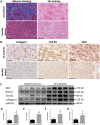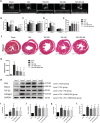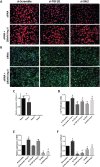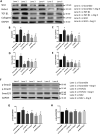Crosstalk between the activated Slit2-Robo1 pathway and TGF-β1 signalling promotes cardiac fibrosis
- PMID: 33236535
- PMCID: PMC7835586
- DOI: 10.1002/ehf2.13095
Crosstalk between the activated Slit2-Robo1 pathway and TGF-β1 signalling promotes cardiac fibrosis
Abstract
Aims: Previous reports indicated that the Slit2-Robo signalling pathway is involved in embryonic heart development and fibrosis in other solid organs, but its function in adult cardiac fibrosis has not been investigated. Here, we investigate the role of the Slit2-Robo1 signalling pathway in cardiac fibrosis.
Methods and results: The right atrial tissue samples were obtained from patients with valvular heart disease complicated by atrial fibrillation during heart valve surgery and from healthy heart donors. The fibrotic animal model is created by performing transverse aortic constriction (TAC) surgery. The Robo1, Slit2, TGF-β1, and collagen I expression levels in human and animal samples were evaluated by immunohistochemistry and western blot analysis. Echocardiography measured the changes in heart size and cardiac functions of animals. Angiotensin II (Ang II), Slit2-siRNA, TGF-β1-siRNA, recombinant Slit2, and recombinant TGF-β1 were transfected to cardiac fibroblasts (CFs) respectively to observe their effects on collagen I expression level. The right atrial appendage of patients with valvular heart disease complicated by atrial fibrillation found significantly up-regulated Slit2, Robo1, TGF-β1, and collagen I expression levels. TAC surgery leads to heart enlargement, cardiac fibrosis, and up-regulation of Slit2, Robo1, TGF-β1, and collagen I expression levels in animal model. Robo1 antagonist R5 and TGF-β1 antagonist SB431542 suppressed cardiac fibrosis in TAC mice. Treatment with 100 nM Ang II in CFs caused significantly increased Slit2, Robo1, Smad2/3, TGF-β1, collagen I, PI3K, and Akt expression levels. Transfecting Slit2-siRNA and TGF-β1-siRNA, respectively, into rat CFs significantly down-regulated Smad2/3 and collagen I expression, inhibiting the effects of Ang II. Recombinant Slit2 activated the TGF-β1/Smad signalling pathway in CFs and up-regulated Periostin, Robo1, and collagen I expression.
Conclusions: The Slit2-Robo1 signalling pathway interfered with the TGF-β1/Smad pathway and promoted cardiac fibrosis. Blockade of Slit2-Robo1 might be a new treatment for cardiac fibrosis.
Keywords: Cardiac fibrosis; Crosstalk; Signalling pathway; Slit2; TGF-β1.
© 2020 The Authors. ESC Heart Failure published by John Wiley & Sons Ltd on behalf of European Society of Cardiology.
Conflict of interest statement
The authors declare that they have no conflict of interest.
Figures






Similar articles
-
Activation of Slit2-Robo1 signaling promotes liver fibrosis.J Hepatol. 2015 Dec;63(6):1413-20. doi: 10.1016/j.jhep.2015.07.033. Epub 2015 Aug 8. J Hepatol. 2015. PMID: 26264936
-
Recombinant Slit2 attenuates tracheal fibroblast activation in benign central airway obstruction by inhibiting the TGF-β1/Smad3 signaling pathway.Mol Cell Probes. 2024 Feb;73:101947. doi: 10.1016/j.mcp.2023.101947. Epub 2023 Dec 22. Mol Cell Probes. 2024. PMID: 38122948
-
Reduced USP33 expression in gastric cancer decreases inhibitory effects of Slit2-Robo1 signalling on cell migration and EMT.Cell Prolif. 2019 May;52(3):e12606. doi: 10.1111/cpr.12606. Epub 2019 Mar 21. Cell Prolif. 2019. PMID: 30896071 Free PMC article.
-
SLIT3-mediated fibroblast signaling: a promising target for antifibrotic therapies.Am J Physiol Heart Circ Physiol. 2023 Dec 1;325(6):H1400-H1411. doi: 10.1152/ajpheart.00216.2023. Epub 2023 Oct 13. Am J Physiol Heart Circ Physiol. 2023. PMID: 37830982 Free PMC article. Review.
-
Research Progress of Traditional Chinese Medicine in Treatment of Myocardial fibrosis.Front Pharmacol. 2022 Jun 8;13:853289. doi: 10.3389/fphar.2022.853289. eCollection 2022. Front Pharmacol. 2022. PMID: 35754495 Free PMC article. Review.
Cited by
-
Causal relationships between 4907 circulating proteins and heart failure and atrial fibrillation: A bidirectional Mendelian randomization study.Medicine (Baltimore). 2025 Jul 4;104(27):e43198. doi: 10.1097/MD.0000000000043198. Medicine (Baltimore). 2025. PMID: 40629581 Free PMC article.
-
Recombinant Slit2 suppresses neuroinflammation and Cdc42-mediated brain infiltration of peripheral immune cells via Robo1-srGAP1 pathway in a rat model of germinal matrix hemorrhage.J Neuroinflammation. 2023 Oct 29;20(1):249. doi: 10.1186/s12974-023-02935-2. J Neuroinflammation. 2023. PMID: 37899442 Free PMC article.
-
Urine peptidome analysis in cardiorenal syndrome reflects molecular processes.Sci Rep. 2021 Aug 10;11(1):16219. doi: 10.1038/s41598-021-95695-z. Sci Rep. 2021. PMID: 34376786 Free PMC article.
-
CCN2/CTGF promotes liver fibrosis through crosstalk with the Slit2/Robo signaling.J Cell Commun Signal. 2023 Mar;17(1):137-150. doi: 10.1007/s12079-022-00713-y. Epub 2022 Dec 5. J Cell Commun Signal. 2023. PMID: 36469291 Free PMC article.
-
Identification of Shared Signature Genes and Immune Microenvironment Subtypes for Heart Failure and Chronic Kidney Disease Based on Machine Learning.J Inflamm Res. 2024 Mar 21;17:1873-1895. doi: 10.2147/JIR.S450736. eCollection 2024. J Inflamm Res. 2024. PMID: 38533476 Free PMC article.
References
-
- Meagher P, Adam M, Connelly K. It's not all about the cardiomyocyte: fibroblasts, empagliflozin, and cardiac remodelling. Can J Cardiol 2020; 36: 464–466. - PubMed
Publication types
MeSH terms
Substances
LinkOut - more resources
Full Text Sources
Miscellaneous

